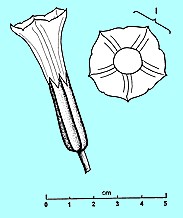
Synonymy
*Datura ferox L., Amoen. Acad. 3: 403 (1756)
T: `Habitat in China'; Lectotype = "Stramonium ferox" in Boccone, Icon. Descr. Rar. Pl. Siciliae, 50, t. 26, f. c, e, 51, 1674; fide Hammer & al. in Kulturpflanze 31: 48 (1983); n.v.
See the Linnaean Plant Name Typification Project pages for further details. Here the comment is made that this species is probably only a variant of D. quercifolia Kunth and in the USDA Germplasm Resources Information Network (GRIN) pages this is confirmed when it is indicated that the two are probably conspecific. The earlier name is D. ferox. Images of both species can be seen on the web-site of the Datura and Brugmansia Society where distinctions between the two species are also shown.
See also Hadkins et al.(1997) for a discussion of the typification of the species and an illustration of the lectotype.
E. S. Hadkins, R. Bye, W. A. Brandenburg, C. E. Jarvis (1997). Typification of Linnaean Datura names (Solanaceae). Bot. J. Linnean Soc. 125: 295-308.
Description
Stout annual herb, glabrous or sparsely pubescent with non-glandular hairs.
Mature leaves from broadly-ovate and somewhat angular to rounded-triangular, the lamina up to 14 cm long, 16 cm wide, with a few shallow usually toothed or sinuate lobes.
Calyx to 3.5 cm long, 5–lobed, persistent in fruit, the lobes 4–7 mm long. Corolla 4–6 cm long, white, 5–lobed, the lobes ending in a point 1–2 mm long. Stamens not exserted; anthers 3–4 mm long. Style c. 3 cm long; stigma below anthers.
Capsule ellipsoid or nearly so, to 4 cm long, erect, spiny; spines usually 40–60, stout, conical, sharp, usually longer near capsule summit, the longest at least half length of capsule; persistent base of calyx base to 8 mm long. Seeds 4–5 mm long, black or grey.
Distribution and ecology
Native to China but now widely distributed in warm regions of the world. In Australia, occurs in all states.
A weed of waste ground, and disturbed areas in agricultural and pastoral districts; often a serious weed of summer grain crops in Qld and N.S.W.
Common name
Fierce Thornapple, Longspine Thornapple
Notes
The plants sometimes contaminate harvested grain.
Hybrids between D. ferox and D. stramonium are known to occur naturally (Haegi, 1976).
Selected specimens
W.A.: Serpentine, Apr. 1965, L & E Fawcett (PERTH). N.T.: near Adelaide River, 7 Feb. 1971, G. Brown (NT). S.A.: Adelaide, L. Haegi 605 (AD); Qld: near Monto, 3 Nov. 1976, E.M. Ross (BRI). N.S.W.: Finley, D.E. Symon 9805 (ADW, CANB, NSW).
Derivation of epithet
From the Latin ferox, fierce, presumably a reference to the fruit of this species.
Images and information on web
The Datura and Brugmansia Society has superb images of all life stages of this species on its site: see www.abads.net/datura/ferox/
An image of the fruit of D. ferox can be seen at http://florabase.calm.wa.gov.au/browse/photo/6960
Further information can be found on the Weeds in Australia site.
A fact sheet on the effects of D. ferox on animals can be downloaded from the Australian Weeds and Livestock pages dealing with the effects of plants on various farm animals.
D. ferox as a weed in the Pacific is treated on the Pacific Island Ecosystems at Risk (PIER) site.
Further information about the toxic properties of this plant can be found with a search in the FDA Poisonous Plant Database
Plant status (if any)
General information about Datura species as declared plants in
All species of Datura are declared in Western Australia, Tasmania and Northern Territory while D. ferox, D. inoxia and D. stramonium are included in Victorian legislation.
Information on the occurrence and declaration of Datura in
A fact sheet for this species can be downloaded from the SA eFlora site.


